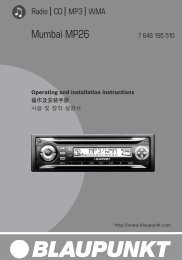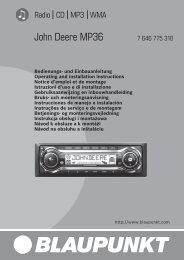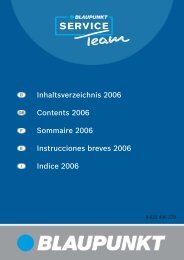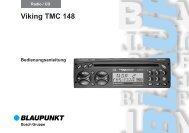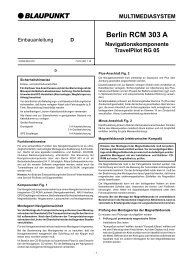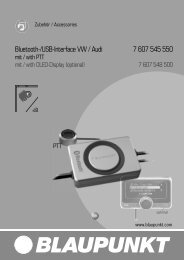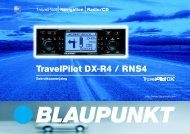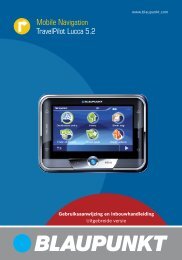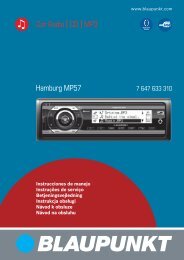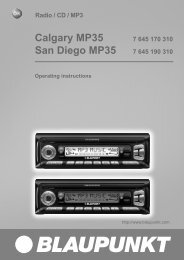Madrid 210; San Francisco 310; Toronto 410 BT - Blaupunkt
Madrid 210; San Francisco 310; Toronto 410 BT - Blaupunkt
Madrid 210; San Francisco 310; Toronto 410 BT - Blaupunkt
You also want an ePaper? Increase the reach of your titles
YUMPU automatically turns print PDFs into web optimized ePapers that Google loves.
CD/MP3/WMA/iPod mode<br />
• MP3 ID3 tags: Version 1 and 2<br />
• Bitrate for creating audio files:<br />
– MP3: 32 to 320 kbps<br />
– WMA: 32 to 192 kbps<br />
• Maximum number of files and directories:<br />
– USB medium: Up to 20,000 entries depending<br />
on the data structure<br />
– SD cards: Up to 1,500 files (directories and<br />
tracks) per directory<br />
iPod mode (not for <strong>Madrid</strong> <strong>210</strong>)<br />
You can connect numerous iPod and iPhone<br />
models to the car sound system via the USB port<br />
and control the audio playback from the car sound<br />
system.<br />
Note:<br />
<strong>Blaupunkt</strong> cannot guarantee the flawless<br />
function of all iPod and iPhone models.<br />
Use a suitable adapter cable to connect your iPod<br />
or iPhone with the USB port of the car sound<br />
system.<br />
Changing to CD/MP3/WMA/iPod<br />
mode<br />
<br />
Press the SRC button > repeatedly until the<br />
desired audio source is displayed:<br />
• "CD": Inserted CD.<br />
• "SD": Inserted SD card<br />
• "USB": Connected USB data carrier.<br />
• "IPOD": Connected iPod<br />
• "AUX": Connected external audio source.<br />
Notes:<br />
• The respective audio source can be selected<br />
only if a corresponding CD is inserted or<br />
a corresponding device is connected.<br />
• A connected iPod is initially selected under<br />
"USB" and as soon as the iPod has been<br />
recognised under "IPOD".<br />
• If the car sound system first has to read<br />
the data of a connected device or data carrier<br />
before the playback, the display shows<br />
"READING". The duration of the reading<br />
depends on the data volume and design of<br />
the device or data carrier. If the device or<br />
data carrier is defective or the transferred<br />
data cannot be played back, a corresponding<br />
message appears on the display (e. g.<br />
"CD ERROR").<br />
Inserting/ejecting a CD<br />
Inserting a CD<br />
Risk of severe damage to the CD<br />
drive!<br />
Noncircular contoured CDs (shape CDs)<br />
and CDs with a diameter of 8 cm (mini CDs) must<br />
not be used.<br />
We accept no responsibility for any damage to the<br />
CD drive that may occur as a result of the use of<br />
unsuitable CDs.<br />
<br />
Note:<br />
You must not hinder or assist the drive as it<br />
automatically draws in the CD.<br />
Insert the CD with its printed side up into the<br />
CD tray 5 until you feel a slight resistance.<br />
The drive automatically draws in the CD and<br />
checks its data. Afterwards, the playback<br />
starts in CD or MP3 mode.<br />
Note:<br />
If the inserted CD cannot be played back, "CD<br />
ERROR" is briefly displayed and the CD is automatically<br />
ejected after approx. 2 seconds.<br />
Ejecting a CD<br />
Note:<br />
You must not hinder or assist the drive as it<br />
ejects the CD.<br />
Press the button 8 to eject an inserted<br />
CD.<br />
Notes:<br />
• If a CD is ejected and not removed, the<br />
drive will automatically draw it back in<br />
again after approx. 10 seconds.<br />
ENGLISH<br />
33





